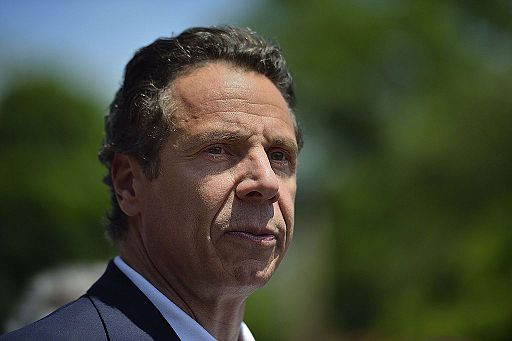Cuomo Starts Re-Election Year & Tough Budget Season with All Ratings Up & Best Favorable Rating Since June 2014
Pluralities Say New Federal Tax Law Will Worsen New York’s Economy & Have Little Effect on Their Personal Finances
Voters’ Top Issue Priorities for the Gov: Taxes & Health Care, Replace Jobs & Education as Top Issues; Strong Support for Many Cuomo SOS Initiatives
Loudonville, NY. Andrew Cuomo begins his eighth year as Governor with his best favorability rating, 62-30 percent, up from 52-43 percent among 2017 likely voters in November, since the middle of his fourth year in office. His job performance rating is 50-48 percent, up from negative 45-54 percent in November, and in his strongest showing this cycle, 55 percent of voters are prepared to re-elect him, compared to 36 percent who prefer ‘someone else,’ according to a new Siena College poll of New York State registered voters released today.
A plurality of 43 percent say the new Federal tax law will worsen New York’s economy, compared to 24 percent who say it will improve the economy and 21 percent say it will have little effect. A plurality of 45 percent says they will be about the same financially as a result of the new tax law, while 33 percent say they will be worse off, and only 15 percent say they will be better off financially. Taxes and health care are the top two issues voters want the Governor to focus on, replacing perennial favorites, education and jobs.
“Election Day is 42 weeks away. Many political lifetimes. Budgets, trials, legislation, ribbon cuttings, natural or other disasters (hopefully not), Federal issues, and unforeseen events likely to impact the political landscape. That said, Andrew Cuomo enters a re-election year with his best favorability rating since the last re-election campaign, his best job performance rating in eight months, his best re-elect rating in this cycle, and a potpourri of State of the State proposals that are popular with New York voters,” said Siena College pollster Steven Greenberg.
“Cuomo’s favorability rating is up net 23 points since November’s poll of likely 2017 voters, and up net 10 points since the October’s Siena College poll of registered voters. He is viewed favorably in every region, including upstate, for the first time since last May, by a 10-point bulge. While a majority of Republicans still views him unfavorably, 41 percent view him favorably, up nine points from November,” Greenberg said. “As many watch to see if Cuomo will be challenged from the left again, he has an 80-14 percent favorability rating with liberals.”
“Cuomo’s tack to the left has resonated with voters as 41 percent – the highest percentage ever – describe him as a liberal and 40 percent – the lowest percentage ever – identify Cuomo as a moderate, with only 10 percent calling him a conservative,” Greenberg said.
“As we start an election year for every statewide office, a US Senate seat, every member of the House and State Legislature, Cuomo sits atop the lineup of New York pols in terms of favorability rating,” Greenberg said. “On the other hand, State Comptroller Tom DiNapoli, essentially unknown to more than six in ten voters, is the only one of a dozen officials and institutions to be viewed favorably by Democrats, Republicans and independents.”
NYers on Federal Tax Bill: 24% Say it Will Improve Economy; 15% Say It Will Help Them Financially
“A plurality of Republicans thinks the new Federal tax law will improve the state’s economy, however, a majority or plurality of Democrats, independents and voters from every region thinks the new law will worsen the economy of the state,” Greenberg said.
“And when it comes to how the tax bill affects New Yorkers personally, a plurality of voters from every party, region, gender or age says they will be about the same financially under the law. There are as many Republicans who think they will be better off financially as there are Republicans who think they will be worse off,” Greenberg said. “However, among other parties and regions, as well as genders and age, more voters say they will be worse off financially than say they will be better off as a result of the new law.
“Given how voters feel about the federal tax bill now there has been little political downside for opposing the law, as the Governor spent weeks doing. And given the little difference between how upstaters and downstaters feel on both questions, it will be interesting to see how voters treat three downstate and two upstate Republican House members who voted no, versus the four upstate House GOP members who voted yes,” Greenberg said.
Taxes & Health Care Replace Jobs & Education As Top Priorities for New Yorkers
“Taxes and health care have replaced jobs and education as the top two issues they want the Governor to make priorities this year,” Greenberg said. “Taxes is the top issue for Republicans and independents, while health care is the top issue for Democrats. Similarly, health care is the top issue for New York City voters, while taxes tops the list for upstate and downstate suburban voters. Jobs, a perennial top two issue for the last decade, has fallen to fifth place, behind even infrastructure.”
Governor’s State of the State Includes Many Proposals with Strong Voter Support
“Passing the Child Victims Act, prohibiting public money to settle sexual harassment claims and instituting early voting all have bipartisan support of at least 65 percent. Despite Republican opposition, the Dream Act enjoys the support of 60 percent of New Yorkers, its strongest-ever support in a Siena College poll,” Greenberg said. “Republicans also oppose suing the Federal government over the tax law and eliminating monetary bail for misdemeanors and non-violent felonies, both supported by independents and strongly supported by Democrats.”
# # #
This Siena College Poll was conducted January 7-11, 2018 by telephone calls conducted in English to 824 New York State registered voters. Respondent sampling was initiated by asking for the youngest male in the household. It has an overall margin of error of + 4.0 percentage points including the design effects resulting from weighting. Sampling was conducted via a stratified dual frame probability sample of landline and cell phone telephone numbers (both from Survey Sampling International) from within New York State weighted to reflect known population patterns. Data was statistically adjusted by age, party, region and gender to ensure representativeness. The Siena College Research Institute, directed by Donald Levy, Ph.D., conducts political, economic, social and cultural research primarily in NYS. SCRI, an independent, non-partisan research institute, subscribes to the American Association of Public Opinion Research Code of Professional Ethics and Practices. For more information, call Steve Greenberg at (518) 469-9858. For survey cross-tabs: www.Siena.edu/SCRI/SNY.




